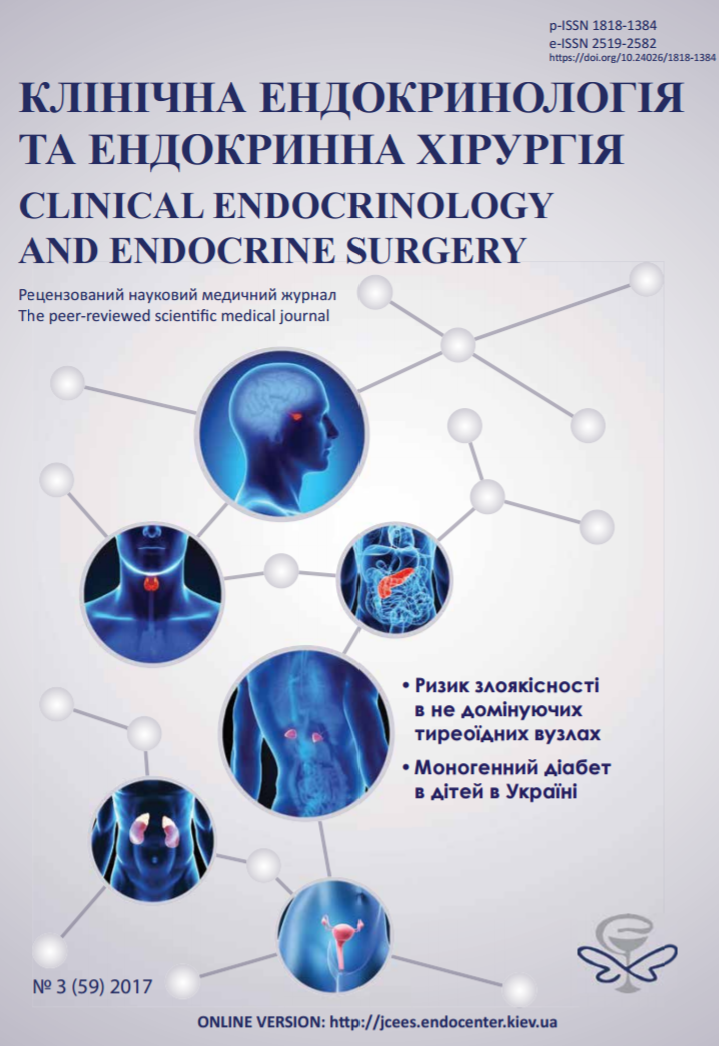Діагностика та лікування кислотозалежної патології у хворих на цукровий діабет
DOI:
https://doi.org/10.24026/1818-1384.3(59).2017.110887Ключові слова:
кислотозалежна патологія, цукровий діабет, діагностика та лікуванняАнотація
У статті розглянуто особливості діагностики та лікування кислотозалежної патології, в першу чергу пептичної виразкової хвороби (ПВХ) і гастроезофагеальної рефлюксної хвороби (ГЕРХ) у хворих на цукровий діабет (ЦД). При діагностиці кислотозалежної патології у хворих на ЦД повинні враховуватися дані ендоскопії та морфологічного дослідження біоптатів, інфікованість H. pylori, компенсація ЦД, наявність неалкогольної жирової хвороби печінки, можлива супутня патологія щитоподібної залози, прийом гастротоксичних препаратів. Лікування ПВХ і ГЕРХ у хворих на ЦД грунтується як на усуненні їх провідних етіологічних чинників, так і на усуненні симптомів захворювання і покращенні якості життя цих пацієнтів, що досягається за допомогою адекватного глікемічного контролю, модифікації способу життя і харчування, а також фармакологічної корекції. При проведенні кислотознижувальної терапії перевагу слід віддавати пантопразолу.Посилання
Alekseenko SA, Gordienko SA, Korotun VM, Nikonov YeL. Sravnitelnaya effektivnost razlichnykh skhem antikhelikobakternoy terapii u bolnykh sakharnym diabetom 2 tipa [Comparative efficacy of different antihelicobacter therapy schemes in patients with type 2 diabetes mellitus]. Rossiyskiy Zhurnal Gastroenterologii i Koloproktologii. 2001:2(Suppl.13):10-12. [Russian].
Zinnatullin MR, Tsimmerman YaS, Trusov VV. Sakharnyy diabet i yazvennaya bolezn [Diabetes mellitus and ulcerative disease]. Eksperimentalnaya I Klinicheskaya Gastroenterologiya. 2003;5:17-24. [Russian].
Kolesnikova YeV. Diabeticheskaya gastropatiya: sovremennyy vzglyad na etiopatogenes, diagnostiku i lecheniye [Diabetic gastropathy: current view on ethiopathogenesis, diagnostics and treatment]. Zdorovye Ukrainy. 2007;7/1:62-63. [Russian].
Fedorchenko YuL, Koblova NM, Obukhova GG. Osobennosti techeniya yazvennoy bolezni zheludka I dvenadtsatiperstnoy kishki u bolnykh sakharnym diabetom [Pecularities of the course of ulcerative disease of stomach and duodenum in patients with diabetes mellitus]. Vrach. 2001;7:28-30. [Russian].
Abraham NS, Hlatky MA, Antman EM, et al. ACCF/ACG/AHA 2010 expert consensus document on the concomitant use of proton pump inhibitors and thienopyridines: a focused update of the ACCF/ACG/AHA 2008 expert consensus document on reducing the gastrointestinal risks of antiplatelet therapy and NSAID use. A report of the American college of cardiology foundation task force on expert consensus documents. J Am Coll Cardiol. 2010;56(24):2051-2066. https://doi.org/10.1016/j.jacc.2010.09.010
Banerjee S, Weideman RA, Weideman MW, et al. Effect of concomitant use of clopidogrel and proton pump inhibitors after percutaneous coronary intervention. Am J Cardiol. 2011;107:871-878.
American Diabetes Association. Diagnosis and classification of diabetes mellitus. Diabetes Care. 2011 Jan; 34(Suppl 1): S62-S69. https://doi.org/10.2337/dc11-s062
Anastasios R, Goritsas C, Paramihail C, et al. Helicobacter pylori infection in diabetic patients: prevalence and endoscopic findings. Eur J Int Med. 2002;13(6):376-379. https://doi.org/10.1016/s0953-6205(02)00094-8
Emery MG, Fisher JM, Chien JY, et al. CYP2E1 activity before and after weight loss in morbidly obese subjects with nonalcoholic fatty liver disease. Hepatology. 2003;38:428-435. https://doi.org/10.1053/jhep.2003.50342
FDA reminder to avoid concomitant use of Plavix (clopidogrel) and omeprazole. [Internet]. Available from: www.fda.gov/Drugs/DrugSafety/ucm231161.htm
Fitton A,Wiseman L. Pantoprazole. A review of its pharmacological properties and therapeutic use in acid-related disorders. Drugs. 1996 Mar 51(3):460-482. https://doi.org/10.2165/00003495-199651030-00012
Hagymási K, Müllner K, Herszényi L, Tulassay Z. Update on the pharmacogenomics of proton pump inhibitors. Pharmacogenomics. 2011;12(6): 873-888. https://doi.org/10.2217/pgs.11.4
Johnson DA. Concomitant use of PPIs and antiplatelet therapy. Gastroenterol Hepatol. 2011;7:7-10.
Kotlyar M, Carson SW. Effects of obesity on the cytochrome P450enzyme system. Int J Clin Pharmacol Ther. 1999;37:8-19.
Kromer W, Horbach S, Lühmann R. Relative efficacies of gastric proton pump inhibitors: their clinical and pharmacological basis. Pharmacology. 1999;59:57-77. https://doi.org/10.1159/000028306
Kwok CS, Loke YK. Effects of proton pump inhibitors on platelet function in patients receiving clopidogrel: a systematic review. Drug Saf. 2012;35:127-139. https://doi.org/10.2165/11594900-000000000-00000
Leclercq I, Horsmans Y, Desager JP, et al. Reduction in hepatic cytochrome P-450 is correlated to the degree of liver fat content in animal models of steatosis in the absence of inflammation. J Hepatol. 1998;28:410-416. https://doi.org/10.1016/s0168-8278(98)80314-0
Li X-Q, Andersson TB, Ahlstrom M, Weidolf L. Comparison of inhibitory effects of the proton pump-inhibiting drugs omeprazole, esomeprazole, lansoprazole, pantoprazole, and rabeprazole on human cytochrome P450 activities. Drug Metab Dis. 2004;32(8):821-827. https://doi.org/10.1124/dmd.32.8.821
Ogawa R, Echizen H. Drug-drug interaction profiles of proton pump inhibitors. Clin Pharmacokinet. 2010;49(8):509-533. https://doi.org/10.2165/11531320-000000000-00000
Steinijans V, Huber R, Hartmann M, et al. Lack of pantoprazole drug interactions in man: an updated review. Int J Clin Pharmacol Ther. 1996 May;34(1 Suppl):S31-50.
Trifirò G, Corrao S, Alacqua M, et al. Interaction risk with proton pump inhibitors in general practice: significant disagreement between different drug-related information sources. Br J Clin Pharmacol. 2006;62(5):582-590. https://doi.org/10.1111/j.1365-2125.2006.02687.x
Xia H-Н, Talley NJ, Kam EP, et al. Helicobacter pylori infection is not associated with diabetes mellitus, nor with upper gastrointestinal symptoms in diabetes mellitus. Am J Gastroenterol. 2001 Apr;96(4):1039-1046. https://doi.org/10.1016/s0002-9270(00)02397-2
Wrighton SA, Thummel K. CYP3A. In: Levy RH, Thummel KE, Trager WF, eds. Metabolic drug interactions, chapter 10. Philadelphia: Lippincott Williams &Wilkins, 2000.
##submission.downloads##
Опубліковано
Як цитувати
Номер
Розділ
Ліцензія

Ця робота ліцензується відповідно до Creative Commons Attribution-NonCommercial 4.0 International License.





